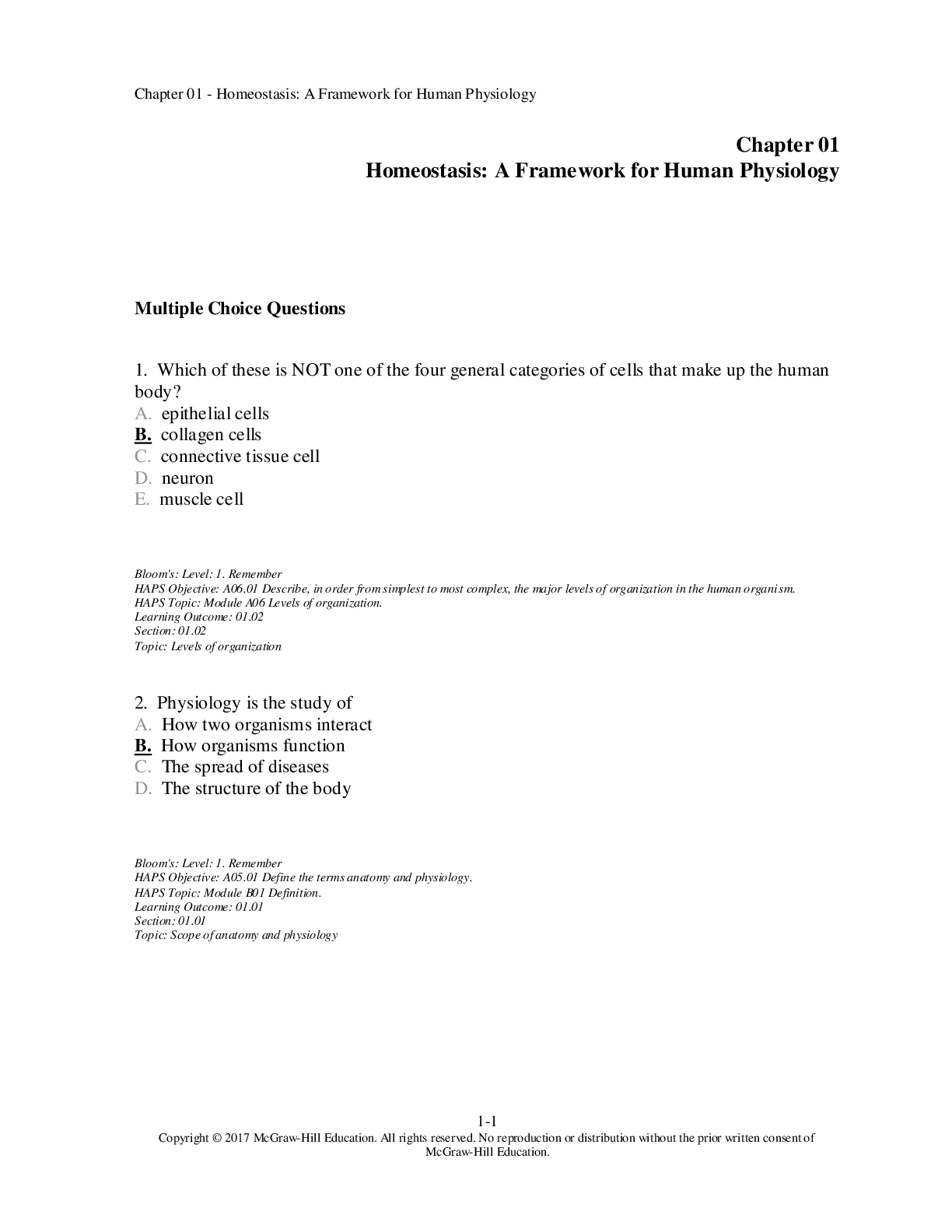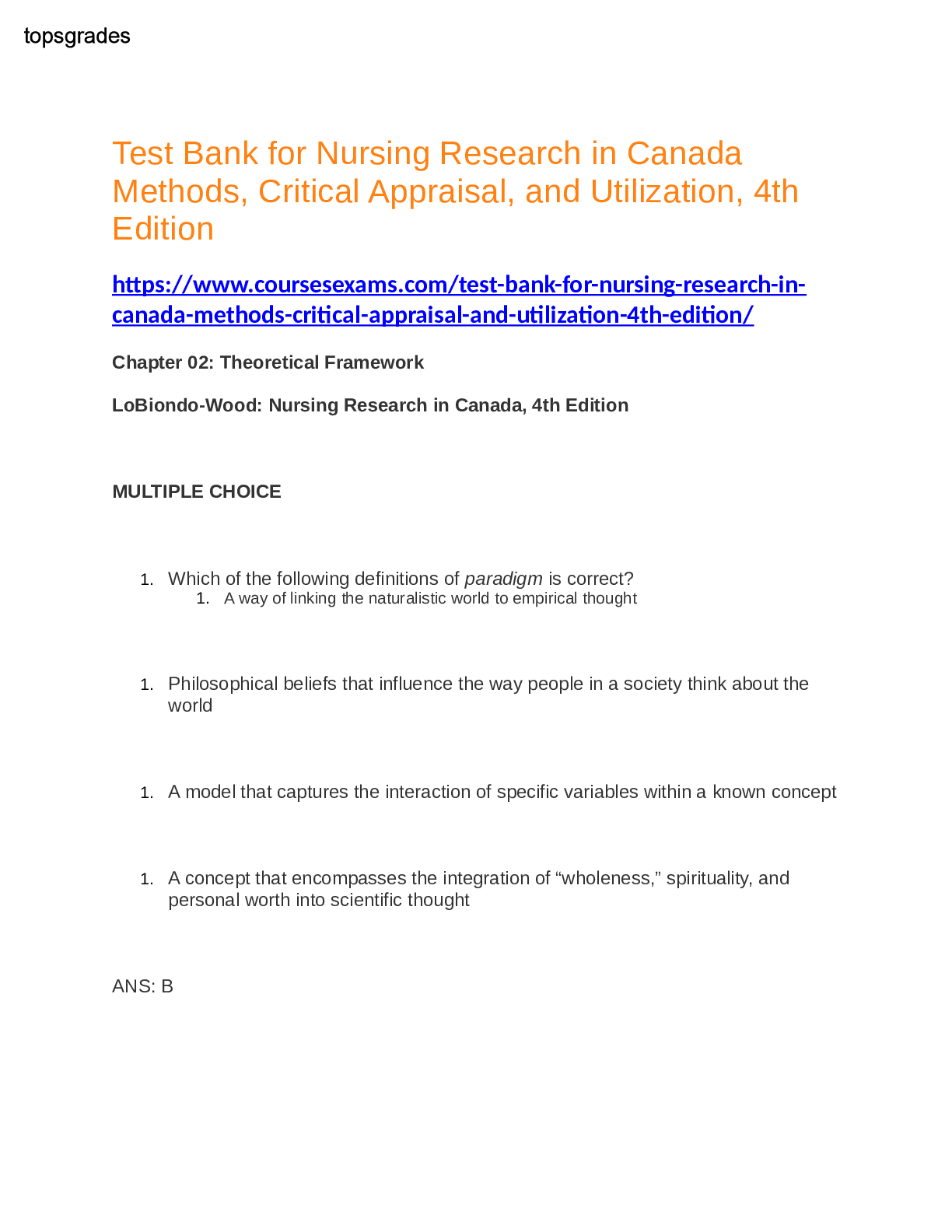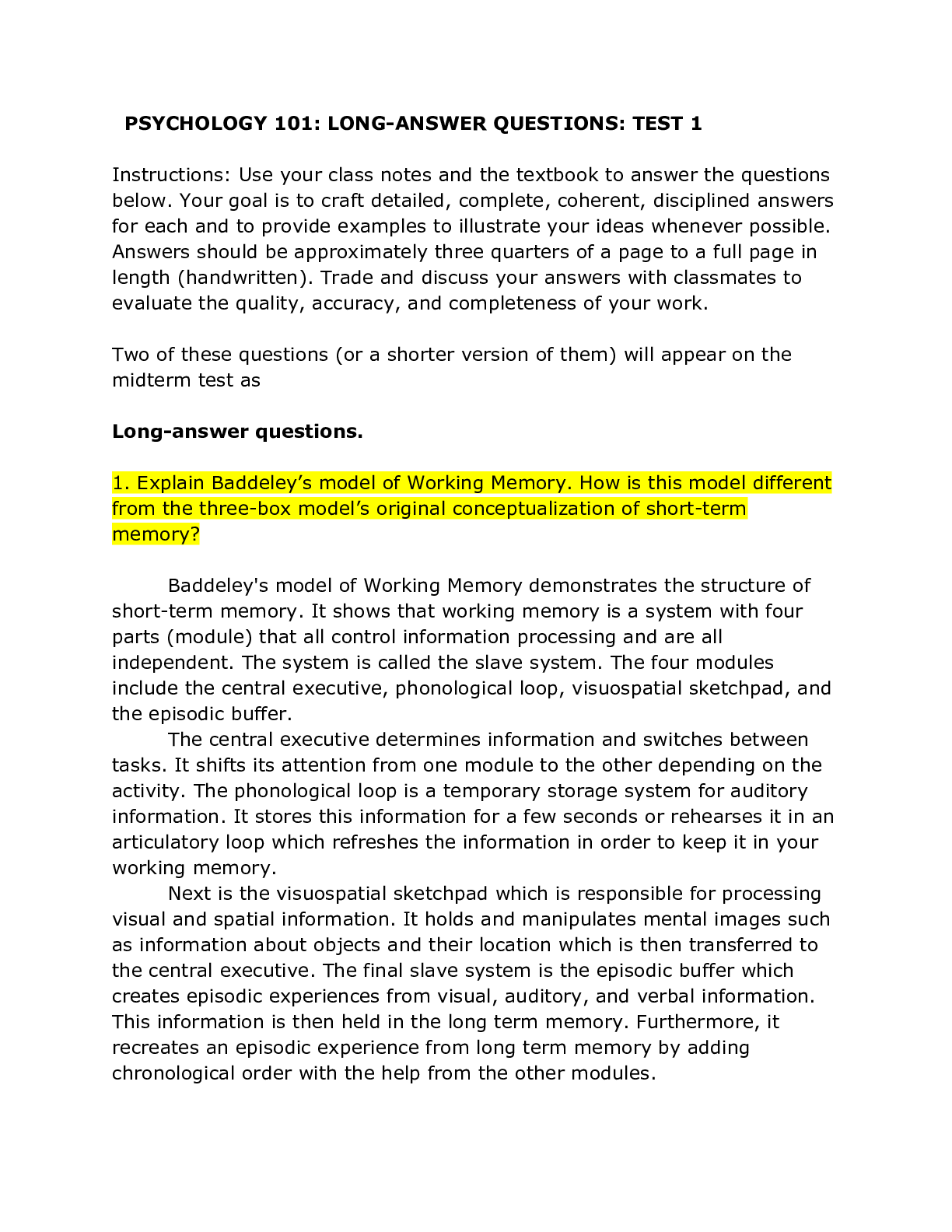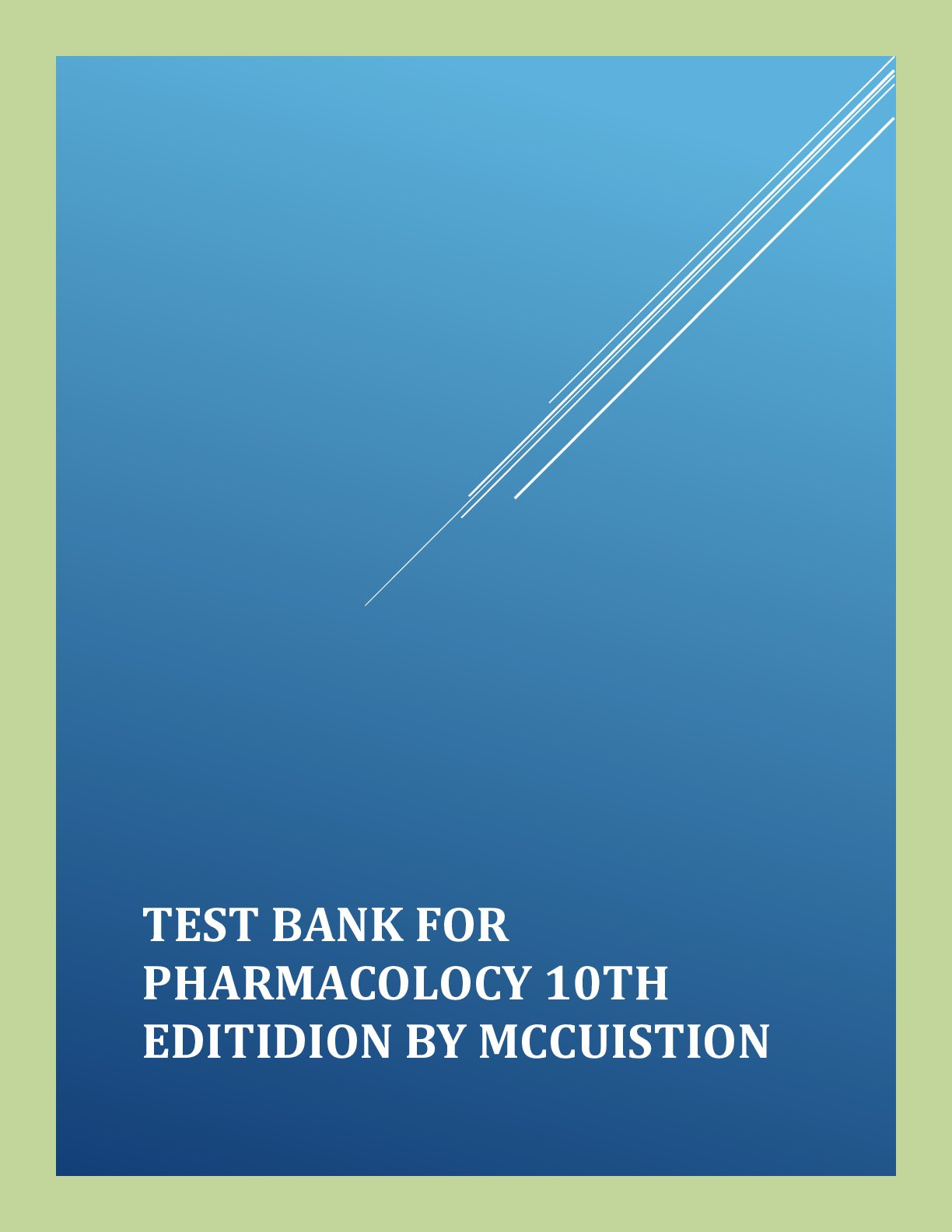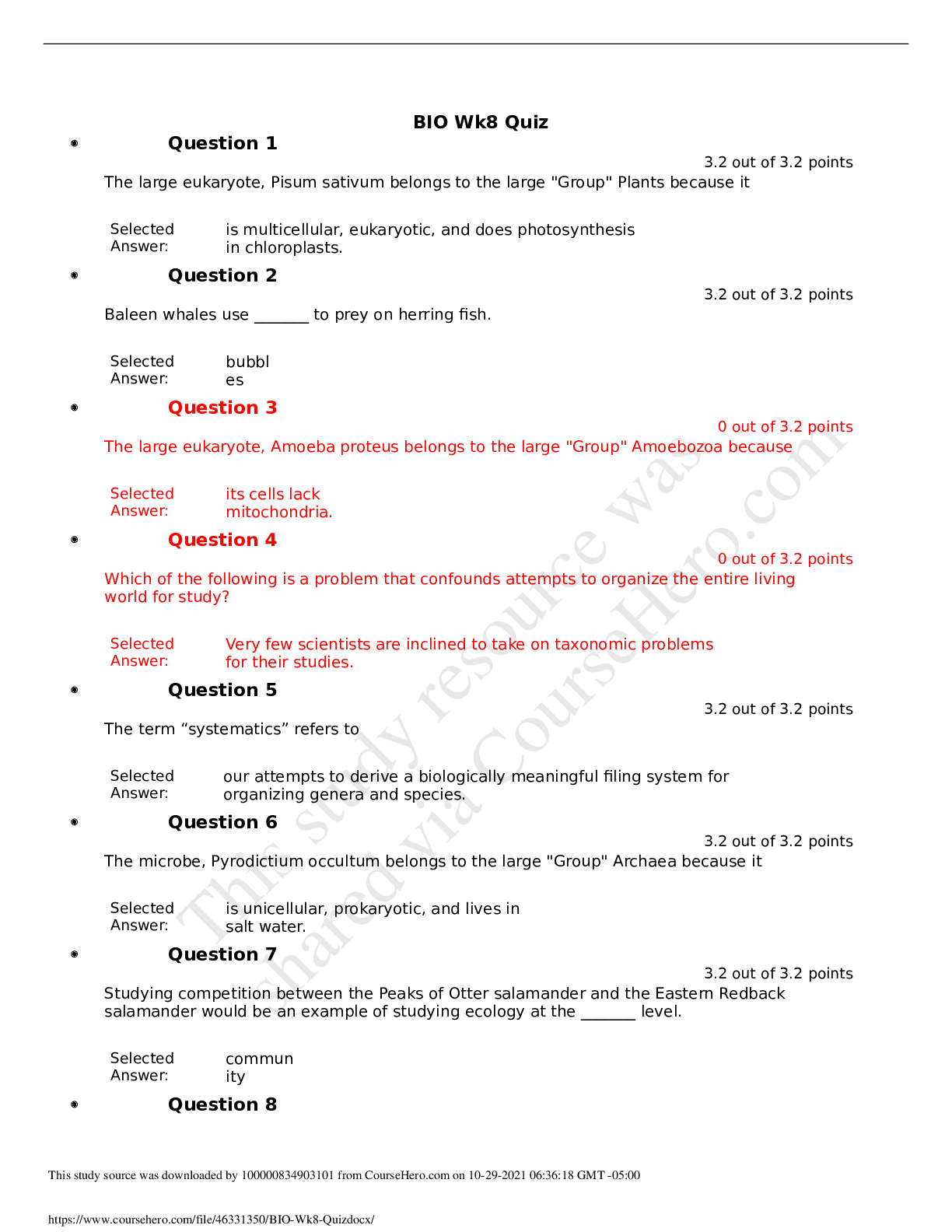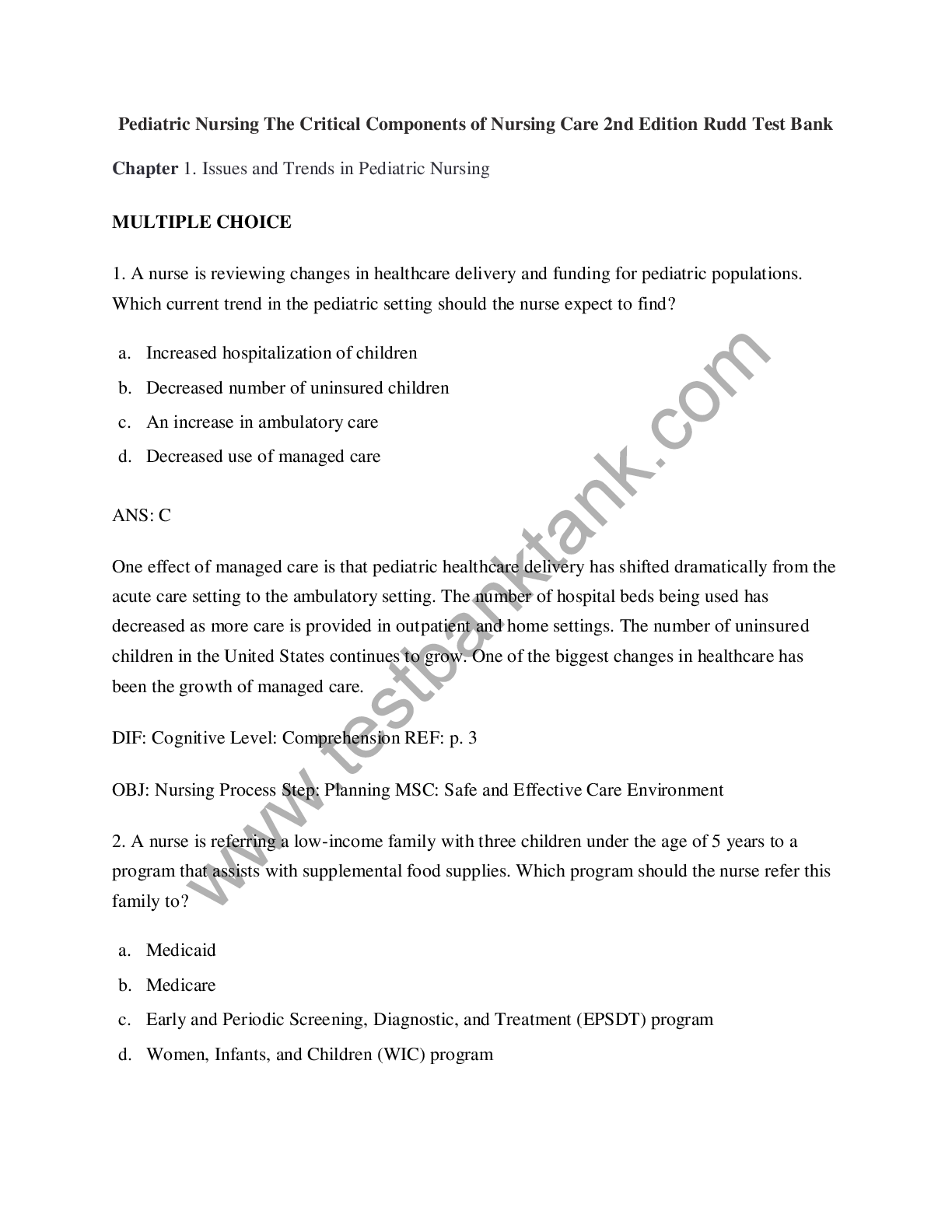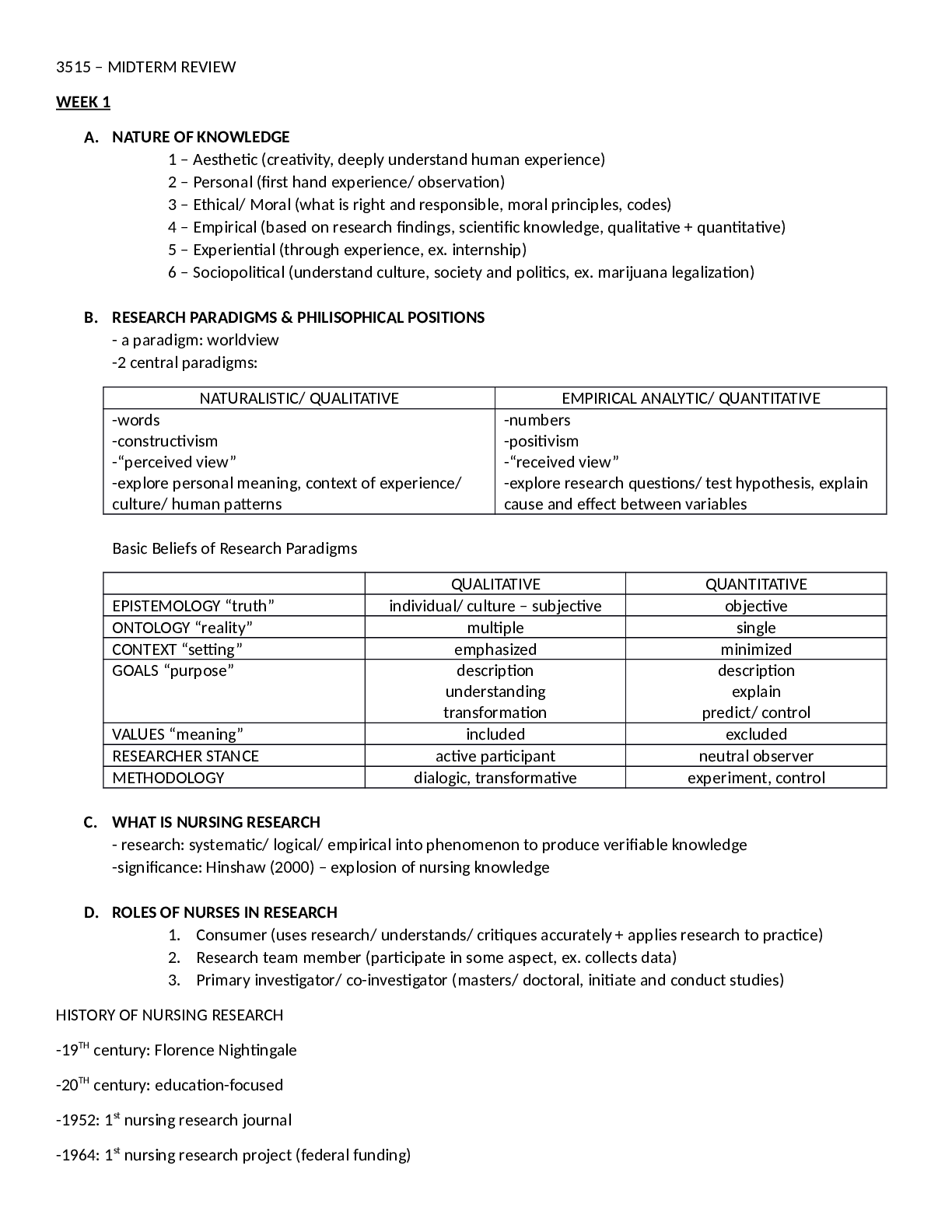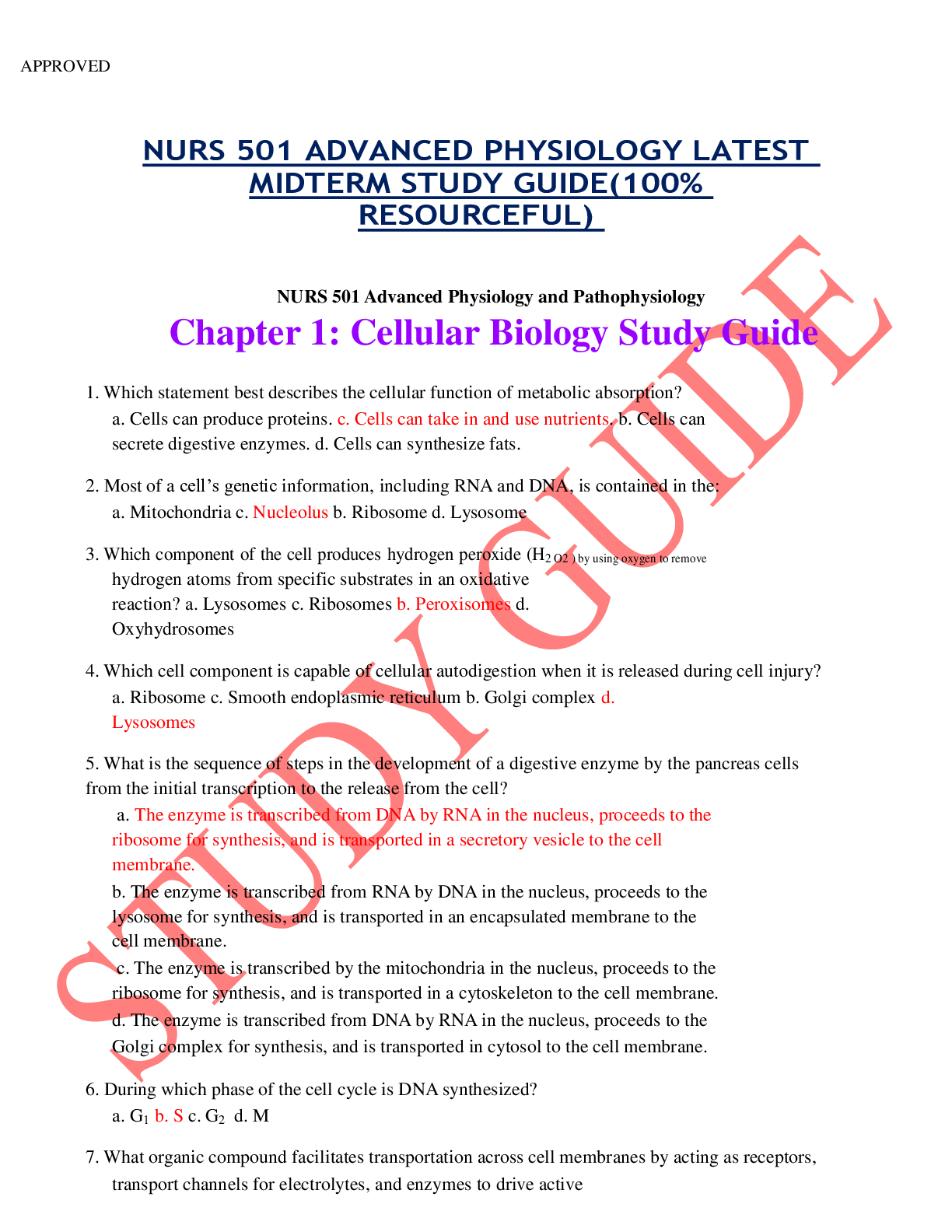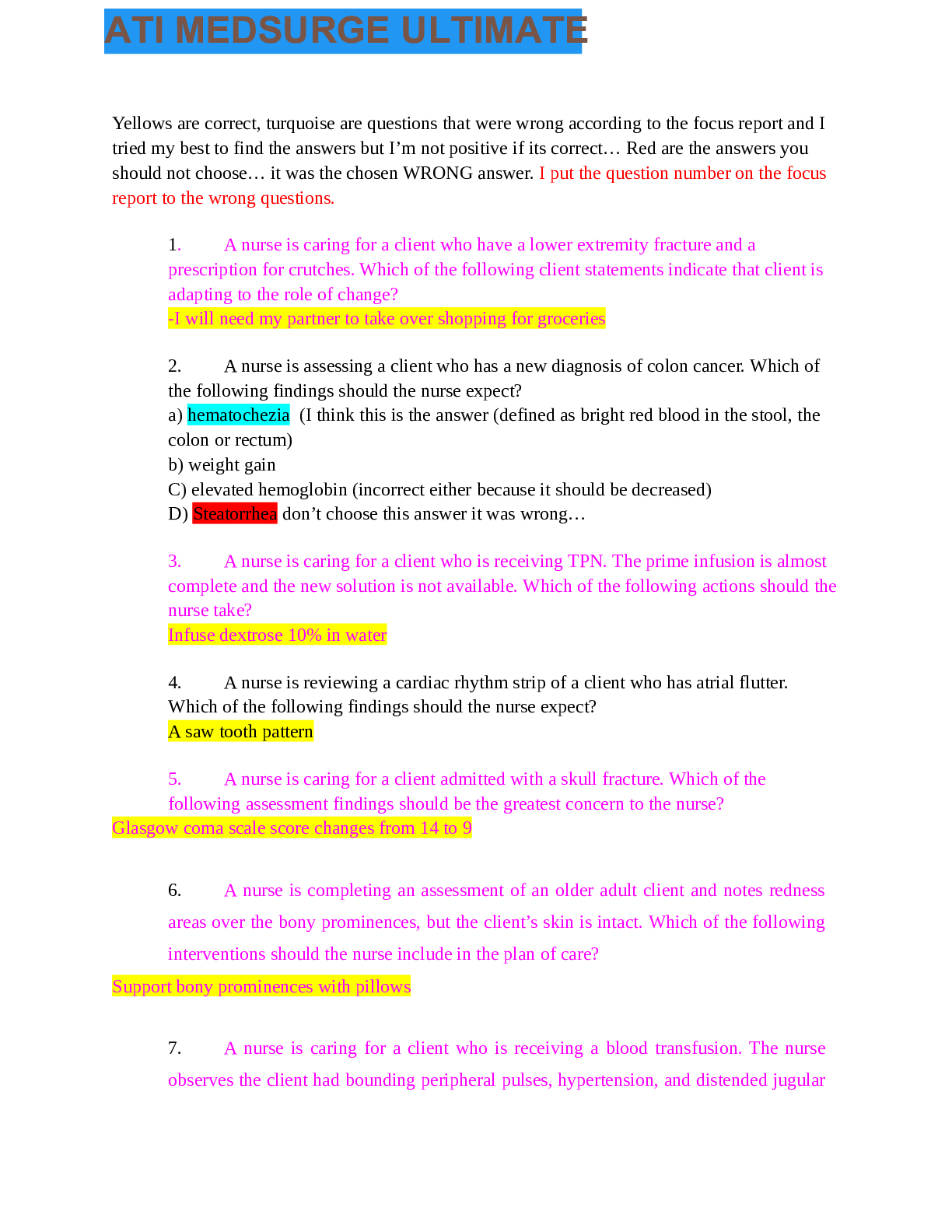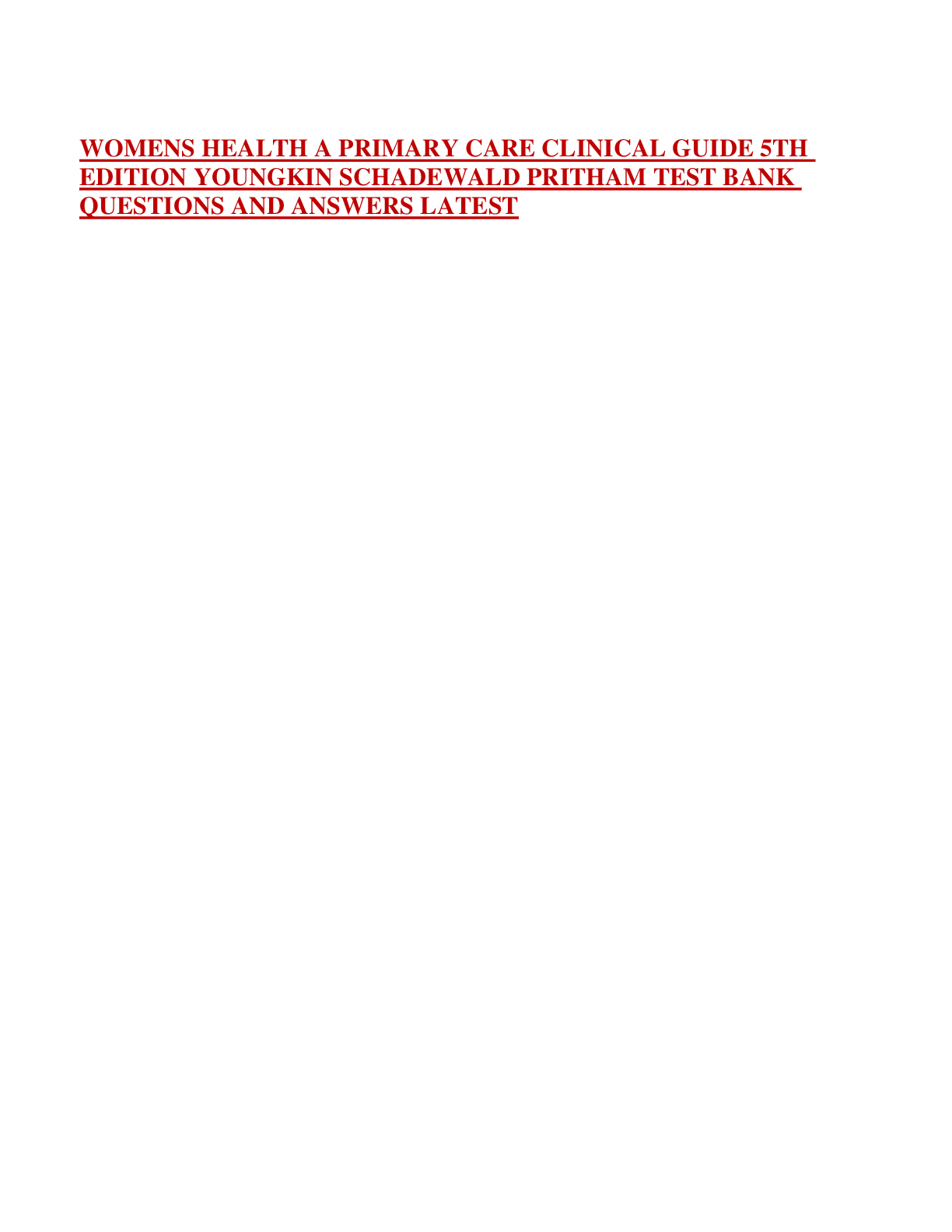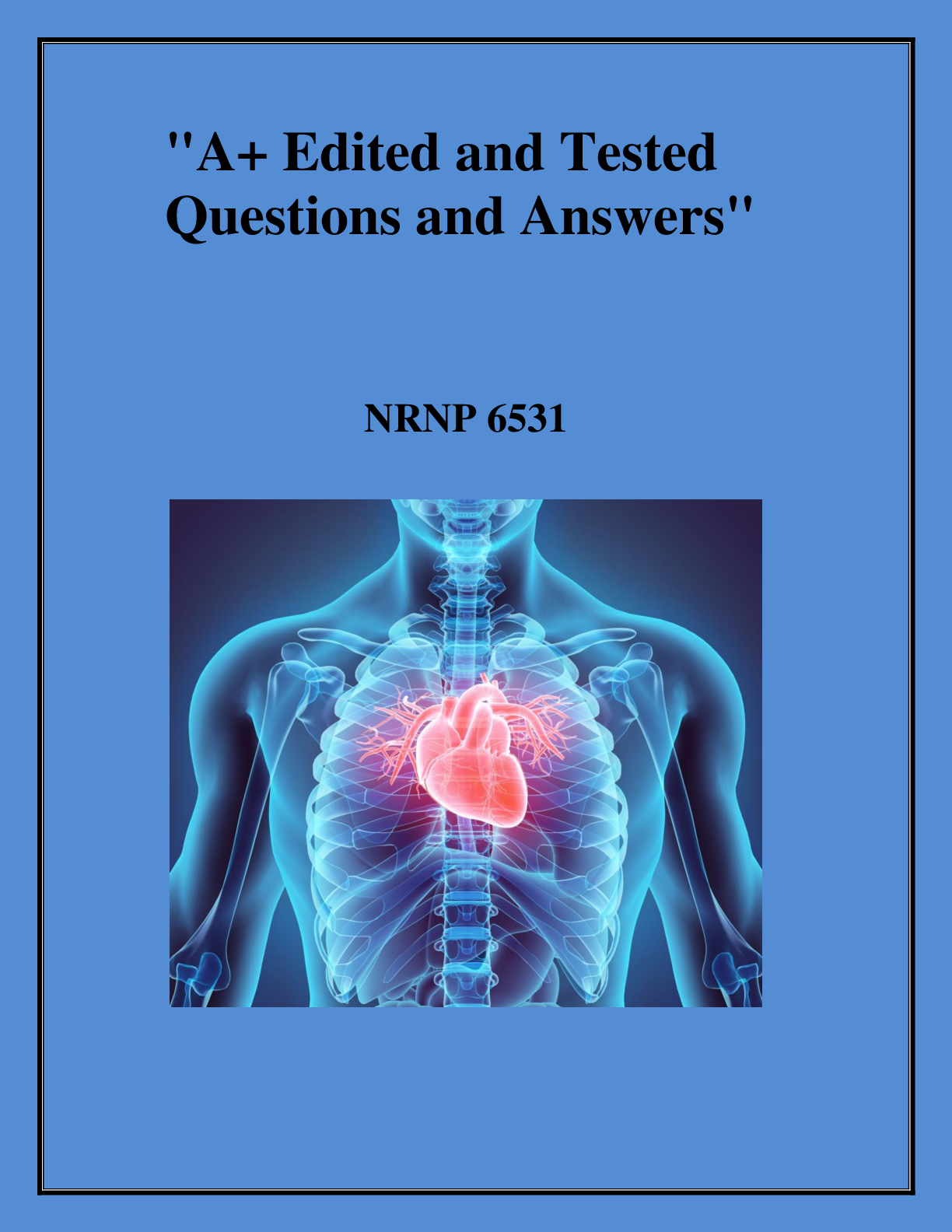*NURSING > AQA Questions and Marking Scheme > Martin Caon Examination Questions and Answers in Basic Anatomy and Physiology 2900 Multiple Choice Q (All)
Martin Caon Examination Questions and Answers in Basic Anatomy and Physiology 2900 Multiple Choice Questions and 64 Essay Topics Third Edition
Document Content and Description Below
Preface Two thousand nine hundred multiple-choice questions (MCQs) that could be asked of a student of introductory human anatomy and physiology are presented in 20 chapters and to more descriptive... ly describe the contents and to facilitate their access are subdivided into 68 categories. In addition, there are 64 topics for a written assignment (essay topics) that may be used in such a course and as an assessment task for such students. It is assumed that users of these questions are teachers or students who have completed at least part of an anatomy and physiology course that might be offered in the first year of a university degree program. It is also assumed that they would have access to one of the Anatomy and Physiology textbooks (or similar) listed in the bibliography below. Each question category has an introduction containing a summary of useful knowledge pertinent to that category of question. However, not all possible information is provided within these introductions, so a textbook is indispensable. The summary introductions are composed of vocabulary that may be unfamiliar to the beginning student but which should be known in order to under- stand the questions. You will need to look up the meaning of many unfamiliar words as your studies progress. All questions have been used at least once, during the author’s teaching career, by the end of semester examinations of a university first-year undergraduate intro- ductory anatomy and physiology course or a physical science course for health sci- ences students to support their anatomy and physiology study. Consequently they reflect the author’s choice of content. Students enrolled in the courses for which these questions were written include nursing, midwifery, paramedic, physiotherapy, occupational therapy, nutrition and dietetics, health science students, exercise sci- ence students and students taking the course as an elective. Many of the students do not have an extensive background in science from their secondary schooling. Some knowledge of physical science is required to understand physiology; hence, physi- cal science questions are included. Students without some background knowledge in chemistry and physics will find such questions challenging and will need to work a little harder to develop their background knowledge. The boundary between chemistry and biochemistry is not distinct; nevertheless, chemistry is implicit in A+ vi physiology. Furthermore, the physics of the body becomes physiology, so gradually that sometimes the boundary between the two is only noticed after it has been crossed. Some questions were difficult to categorise and may span two (or more) catego- ries. Furthermore, in order to answer some questions, you may need knowledge drawn from other “sections” of anatomy different from the name of the section in which the question appears. This is not a bad thing as it emphasises the connected nature of human anatomy and physiology. Each question is unique (there are no duplicates). However, many questions will be examining the same (or similar) material albeit with a differently worded question or a different selection of answers. If the questions are to be used to compile an examination, then care should be taken to exclude questions that are too similar to already selected ones. On the contrary, if the questions are to be used for instruction or study purposes, I would suggest including several similar questions in consecutive order to emphasise the point and to give the students practice. Advice to the Exam Candidate The correct choice of answer for each question is provided. Accompanying the cor- rect choice is a justification for the choice or an explanation of the correct answer and sometimes of why the other choices are incorrect. The degree of difficulty var- ies, but not by intentional design. The perception of difficulty depends on that part of science that the question examines, the level of scientific background brought to the course by the student and their level of studious preparation for the examination. There is only one best correct answer for each of the multiple-choice questions among the four choices presented. However, there may be more than one correct answer. You must choose the best one. In marking multiple-choice questions, I sug- gest that 1 mark be allocated for a correct answer and that a quarter of a mark be deducted for a wrong answer or an unanswered question. Deducting a quarter mark will reduce the score that would be gained by selecting an answer from the four choices purely at random (i.e. guessing), from about 25% to about 6%. Not to deduct a quarter mark is, in my opinion, unsound. Hence, in an examination, the students should never leave a question unanswered. If you cannot decide on an answer, guess at it (after eliminating any choices that you deem to be incorrect). That is, you will be rewarded for the ability to decrease the number of choices from which you are guessing, from 4 to 3 or 2. Be aware of questions that are asked in the negative, that is, have NOT true or FALSE or INCORRECT or EXCEPT one in the stem. In this case, you are seeking a statement that is wrong in order to answer the question. Do not be intimidated by arithmetical calculations. The calculation itself will be simple. Deciding what to add, multiply or divide with what is the tricky part. Some questions have been published before in the book: Caon, M. & Hickman, R. (2003) Human Science: Matter and Energy in the Human Body 3rd edn., Preface A+ vii Crawford House Australia Publishing, Belair South Australia, and are used with the authors’ permission. Some Thoughts on Writing Good MCQs and on Answering Poorly Prepared MCQ Quizzes Ten Pieces of Advice for Writing Good Multiple-Choice Questions 1. Make all the choices of answer about the same length. 2. Do not write choices that use “all of the above”, “none of the above”, “both A and B”, “never”, “all”, etc. (If you cannot think of sufficient choices for distrac- tors, then discard that question.) 3. Use plausible distractors (do not use funny, absurd or cute choices). 4. If the choices are all numbers, list them in order of increasing magnitude. 5. Avoid choices where two are the opposite of each other (one might be guessed to be true). 6. Make the stem ask a question. Do not include irrelevant material in the stem. Do not unintentionally provide a clue in the question. 7. Spread the correct answer evenly (and randomly) among the choices. In ques- tions with four choices of answer, about 25% of the correct choices should be “A”, about 25% “B”, etc. Do not avoid having two or three consecutive answers that are the same letter choice. 8. Limit the number of questions “asked in the negative”, that is, where a false statement is the correct choice. 9. Be grammatically correct when writing the question and the choices. Do not be ambiguous. 10. If only one choice is meant to be the best correct answer, make sure that it is so. Five Ways to Score More Highly on a Poorly Prepared Multiple-Choice Question Test Knowing the subject matter is the best way to score well in a multiple-choice test, but if you do not know the answer, always guess at it after crossing out the obvious wrong answers first. Your guess will then be an educated guess. 1. Eliminate the obvious wrong answers first!!! (a) If marks are deducted for incorrect answers but NOT deducted for unan- swered questions, do not answer the questions you are sure that you do not know the answer to. (b) If one of the choices is “none of the above” or “all of the above”, choose that answer. Preface A+ viii (c) Look at the answers to the preceding and following questions. If you are guessing, do not select a choice that is the same as the previous or the next choice. (This only works if you have chosen those answers correctly!) (d) Choose the longest answer. (e) Eliminate the choices with absolute statements such as never, always and all. Some Thoughts on the Marking of MCQ Tests (Where There Are Four Choices of Answer, One of Which Is the Best Correct) Testing for knowledge is an imprecise science. Using multiple-choice questions (MCQs) for the testing simplifies the marking but also introduces additional uncer- tainties and some unfairness. I award 1 mark for each correct answer. This would mean that someone may score 25% without any study simply by guessing (assuming that correct choices are spread evenly among the four choices). Hence, I also deduct ¼ of a mark for each incorrect answer or unanswered question. With this deduction, it follows that in a 100 question quiz, the mark that a total guesser will score is approximately: 25 cor- rect − (75 incorrect) × ¼ = 25 − 18¾ = 6¼% rather than about 25% if marks were not deducted for incorrect answers. My reasoning is as follows. If you randomly choose the answers for four ques- tions that each have a choice of four answers, the probability of guessing one correct answer from the four questions is: ¼ + ¼ + ¼ + ¼ = 1 and you would be awarded 1 mark out of 4. This would be undeserved as you did not know any answers. By deducting ¼ for each wrong answer, your score for guessing the answers of these four questions would become 1 − ¾ = ¼ mark. The score is still undeserved but more reasonable. Nevertheless, I advise my students to guess at the answer if they do not know it, after eliminating the obviously erroneous choices. If the student can reduce the potentially correct answers from 4 to 3 or 2 before guessing, the proba- bility of guessing correctly from the remaining choices is higher, and they will score more marks. For example the probability of guessing four answers correctly after eliminating one or two obviously incorrect choices may be: 13 12 13 12 1 67+ + + = . . Hence, on average, you would be awarded 1.67 of the 4 marks (minus the deduc- tion for wrong answers). This is reasonable as the student deserves some credit for knowing that some of the choices were wrong. Should a ¼ mark be deducted for each unanswered question? Before I answer this, let us consider four possible strategies for awarding marks to a multiple-choice question quiz with 100 questions. Strategy 1: award 1 mark for a correct answer. Strategy 2: award 1 mark for a correct answer and deduct a 13 mark for wrong answers. Strategy 3: award 1 mark for a correct answer and deduct a ¼ mark for wrong answers. Preface A+ ix Strategy 4: award 1 mark for a correct answer and deduct a ¼ mark for wrong answers AND for unanswered questions. Given that there are four choices to each question and only one is correct and that the correct choice is evenly allocated between choices A, B, C and D, which strategy is fairer? Clearly, the more you get correct, the higher the score. It is also clear that students who bring their knowledge to bear on answering the quiz, that is, are not merely selecting choices at random, will choose far more than 25% of the answers correctly. Consider strategy 1. If a student attempts all questions, the lowest probable score (by random guessing) is 25%, not zero. Hence, 25% is equivalent to zero (no knowl- edge), and the range of possible scores in a four-choice MCQ quiz is from 25 to 100, rather than from 0 to 100. This strategy suffers from rewarding lack of knowledge with 25% of the marks and also constricts the range of marks to about three quarters of the total range. To account for marks obtained by guessing, the examiner may choose to set as a pass mark, a number greater than 50/100 as the passing score for the quiz, for example 60 or 70 or 75/100. If another student leaves some questions unanswered, perhaps because this student does not know the answers, then his or her maximum possible score is reduced by the number of unanswered questions. The scenario for such students remains largely as described above. However, it is possible for both the students to answer the same number of questions correctly and so attain the same score despite the second student leaving some questions unan- swered (Table 1, column 4). The examiner may consider that this outcome is fair. It seems reasonable to me to deduct marks for an incorrect answer when the answer is chosen from four possibilities, as is the case for the type of multiple- choice questions being considered here. It also seems too great a penalty to deduct a mark (or half a mark) for an incorrect choice as the result would be a negative score when less than 50% (or 33%) of questions are answered correctly. Would deducting a 13 mark or a ¼ mark produce a fairer result? Consider strategy 2. In a 100-question quiz, when a 13 mark is deducted for incorrect answers only, Student 1 who answers 50 questions correctly and 50 incor- rectly is awarded 33.3 (see Table 2, column 6). Furthermore, Student 3 who chooses not to answer ten questions but still answers 50 questions correctly (and 40 incor- rectly) is awarded a higher score (36.7) than Student 1. Is this an intended consequence? Compare this with strategy 3 where a ¼ mark (rather than 13 mark) is deducted. The same scenarios above result in Students 1 and 3 being awarded 37.5 and 40, respectively, for their 50 correct answers (see Table 1, column 6), instead of 33.5 and 36.7 (if 13 of a mark were deducted). Hence there is more reward for effort when only a ¼ mark is deducted. However, both the strategies will result in students scoring more highly if they are able to strategically omit answering questions that they are sure they do not know the answer to. Thus students are rewarded for know- ing what they do not know—or for omitting to study a section of the course and avoiding the questions on that part of the course. This is the same as inviting stu- dents to choose which questions they wish to answer and rewarding them for Preface A+ x answering fewer questions. It is for this reason that I deduct a ¼ mark for unan- swered questions. When marks are deducted for wrong answers (but not for unan- swered questions), even for the same number of correct answers (50 in Tables 1 and 2), the more MCQs you leave unanswered (between 0 and 50), the higher will be the score. Hence, students would be encouraged to leave answers to questions that the [Show More]
Last updated: 1 year ago
Preview 1 out of pages
Instant download

Buy this document to get the full access instantly
Instant Download Access after purchase
Add to cartInstant download
Reviews( 0 )
Document information
Connected school, study & course
About the document
Uploaded On
Dec 14, 2022
Number of pages
Written in
Additional information
This document has been written for:
Uploaded
Dec 14, 2022
Downloads
0
Views
7

